
EMI 8-Track Cartridge
#02. Abbey Road (8X-PCS 7088)
(Update: 25th October 2025)



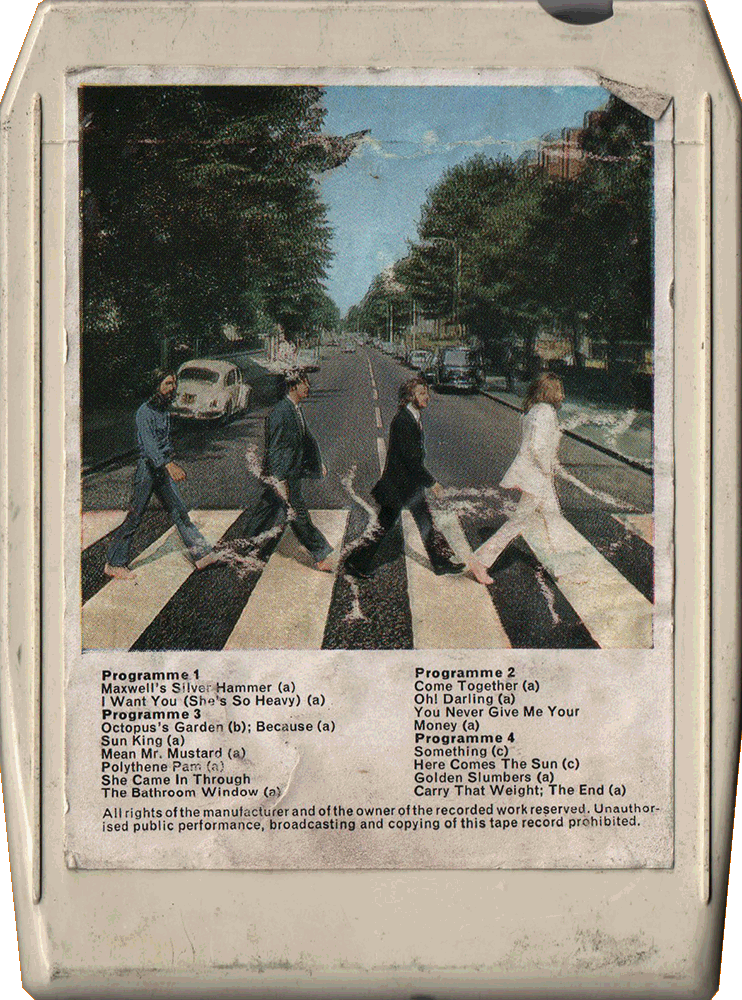 |
|
|
| Parlophone
Original Cartridge |
|
TITLE
|
ABBEY ROAD |
|||
| CATALOG NUMBER | 8X-PCS 7088 | |||
|
RELEASE DATE
|
November 1969 / First Issue? | |||
| TRACK LISTING | PROGRAM 1 | PROGRAM 3 |
||
| Maxwell's Silver Hammer [A3] |
Octopus's Garden [A5] |
|||
| I Want You (She's So Heavy) [A6] | Because [B2] |
|||
| Sun King [B4] |
||||
| Mean Mr. Mustard [B5] |
||||
| Polythene Pam [B6] |
||||
| She Came In Through The Bathroom Window [B7] | ||||
| PROGRAM 2 |
PROGRAM 4 |
|||
| Come Together [A1] |
Something [A2] |
|||
| Oh! Daring [A4] |
Here Comes The Sun [B1] |
|||
| You Never Give Me Your Money [B3] | Golden Slumbers [B8] |
|||
| Carry That Wait [B9] |
||||
| The End [B10] (Her Majesty [B11]) |
||||
| CASSETTE CASE AND TAPE |
CASE FRONT | CASE BACK |
TAPE FRONT | TAPE BACK |
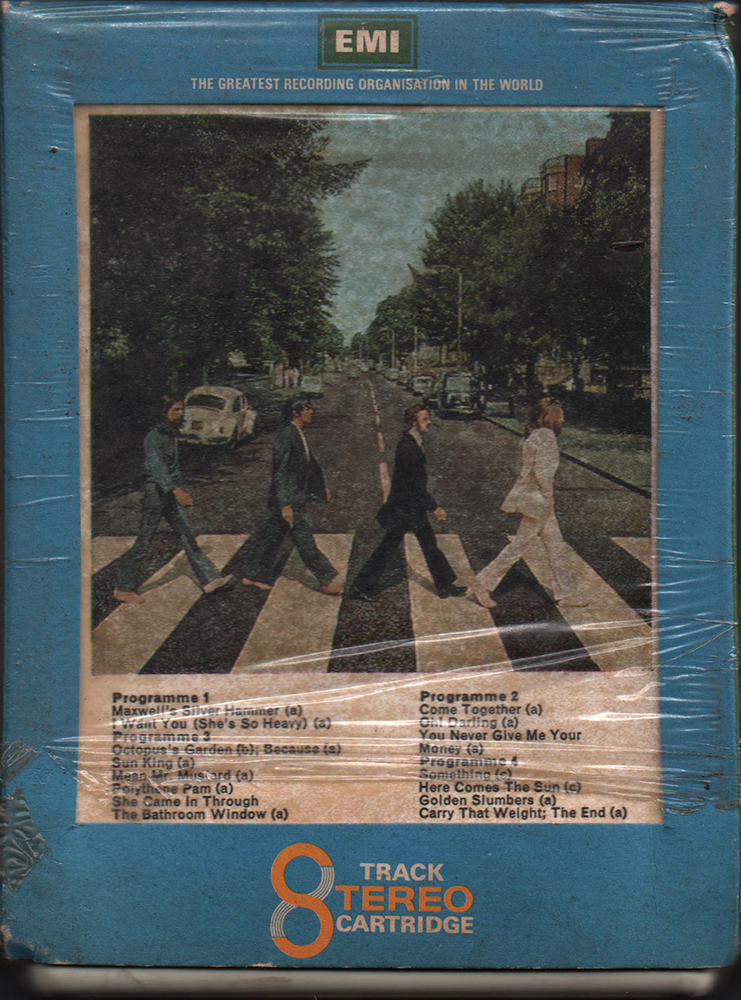 |
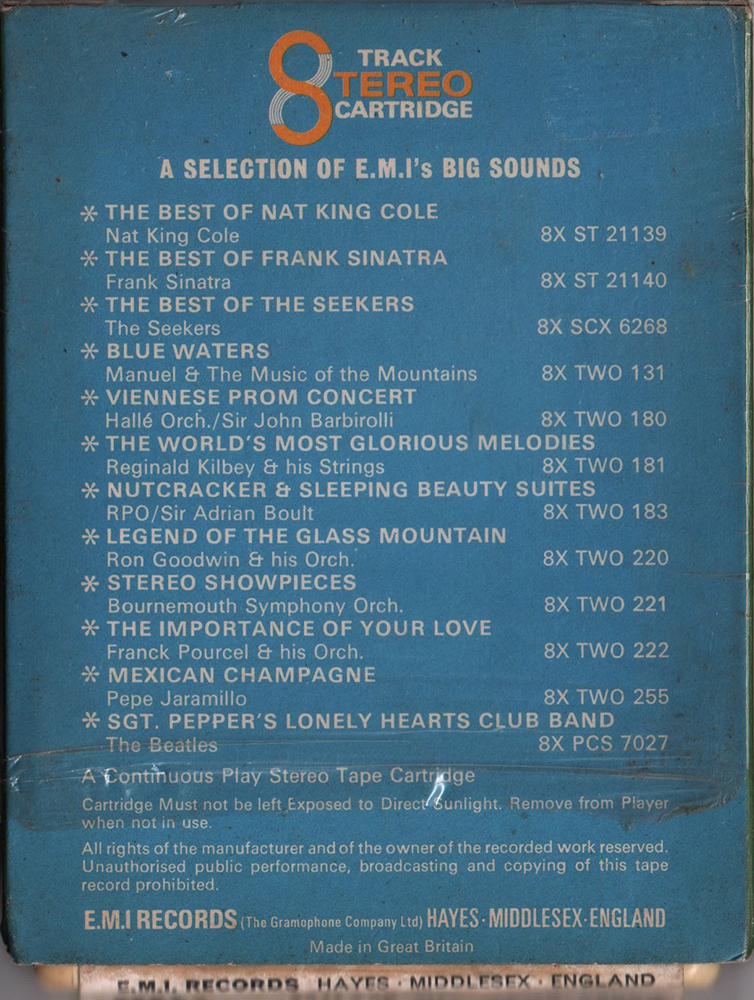 |
 |
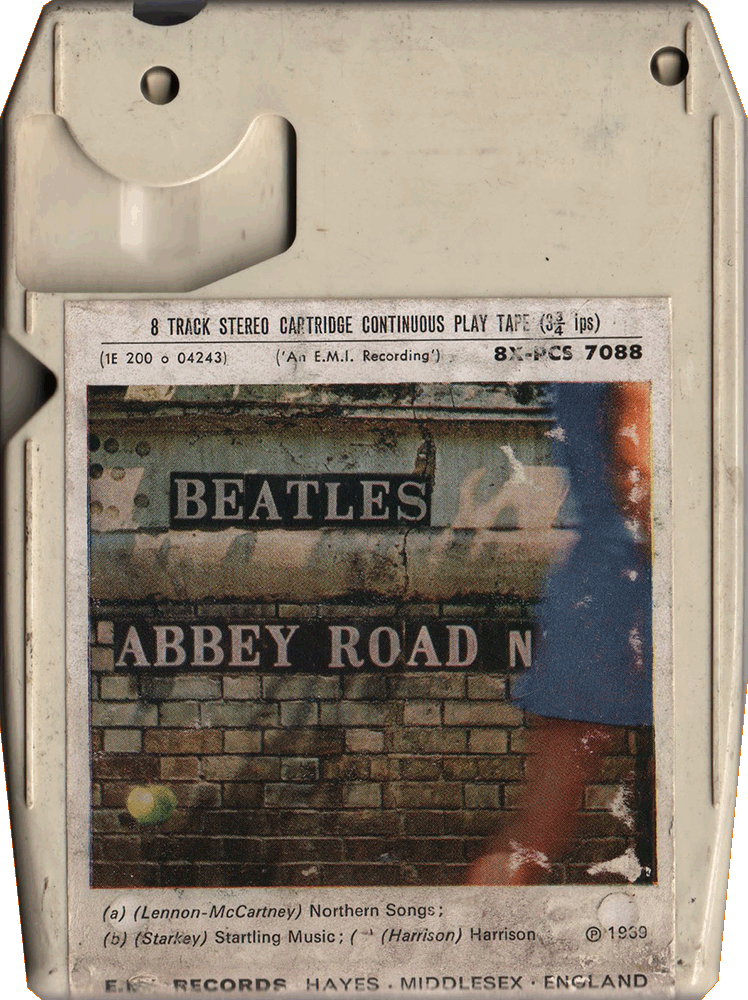 |
|
| cardboard EMI case | The first UK issue of "Sgt. Peppers" has color paper label with
green shell. |
|||
| LABEL |
LABEL: FRONT | LABEL: BACK |
||
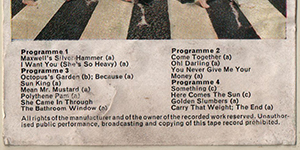 |
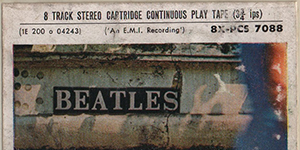 |
|||
| This cartridge
is a white plastic case with a color paper label affixed to
the front face. The four 'programmes' with track listing is
printed in black along with the standard color artwork for
this album. |
With a color
paper label affixed to the front face and end. Album
title, catalog number, and the four 'programmes' with track
listing is printed in black. |
|||
| LABEL: FRONT CLOSE UP | ||||
 |
||||
| The credit "All rights of the
manufacturer and of the owner of the recorded work reserved.
Unauthorised public performance, broadcasting and copying of
this record prohibited." was printed on the label. |
||||
| LABEL: BACK CLOSE UP | ||||
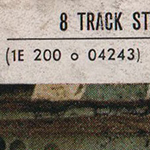 |
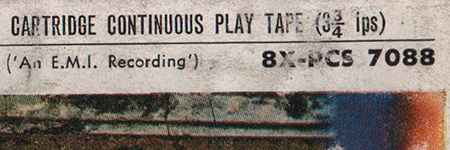 |
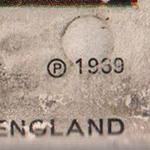 |
||
| EMI country code (*1) was printed on the label. | "3 3/4 ips"
(3.75 inches per second) tape speed. Catalog number "8X-PCS 7027" and "('An E.M.I. Recording')" were printed on the label. |
The "(P) 1969" statement was printed at the right corner of the label. | ||
| LABEL: BACK CLOSE UP | ||||
 |
The words "Made and Printed in Great Britain" was NOT printed at the bottom of the label. | |||
| LABEL: BOTTOM CLOSE UP | ||||
 |
Catalogue number and album
title was printed at the end of the label, but they are partially peeled/missing. |
|||
| OTHER ITEM | ||||
| - | ||||
| LABEL | Color
Paper Label on both sides |
|||
| MIX | STEREO | |||
| RECORD COMPANY'S NAME | EMI Records (The Gramophone Company Ltd) | |||
| CENTRAL REMARK "SOLD IN U.K." |
- |
|||
| RECORDING PUBLISHED CREDIT | (P) 1969 | |||
| SHELL | White Shell |
|||
| CARTRIDGE CASE |
Plastic
tape protector fitted to the top of the cartridge, and
released in generic cardboard EMI case Type-2 |
|||
| PRINTER CREDIT | - |
|||
| COVER DESIGN/ PHOTO/ NOTES | Photo: Iain Macmillan |
|||
| PRODUCER | George Martin | |||
| COMMENTS | This cartridge is a white
plastic shell with a white color paper label
affixed to the front face. The four 'programmes' with track
listing is printed in black along with the standard color
artwork for this album. The 8-track cartridge were issued with a £ Parlophone logo. "IE" catalogue number (*1) in addition to the ordinary "8X-PCS 7088" EMI catalogue number. The magnetic tape is played at 3 3/4 (3.75) inches per second (twice the speed of a cassette). Plastic tape protector fitted to the top of the cartridge, and released in generic cardboard EMI case (maybe). The 8 track cartridge format was jointly developed by Ampex Magnetic Company, RCA Records and Lear Jet Company primarily as a dashboard-based music system for the booming car market. The format was launched in the USA in September 1965, with RCA Victor releasing 175 titles and the Ford Motor Company announcing the format as an option on many of its new 1966 car models. Not long after, players designed for the home began to appear, often incorporated into Reel-to-Reel players. 8 track stereo cartridges comprised four parallel pairs of two-channel stereo programmes: tracks 1 and 5 comprised the first section, 2 and 6 the second, 3 and 7 the third, and 4 and 8 the fourth section. Tracks 1 through 4 were heard through the left speaker while tracks 5 through 8 were heard through the right speaker. All four sections were approximately equal in length and played automatically in sequence. The similar section length often meant that albums had to be re-sequenced to fit the medium, or, in some instances, having songs added, edited or repeated. Conversely, it could also result in long periods of silence between sections. The original Beatles 8 track cartridge release of "Sgt. Peppers" in Oct. or Nov. 1969, through "Abbey Road (Nov. 1969)", "Let It Be (August 1970)", and the first release of most of the other Beatles 8 track albums in Sept. and Oct, 1970, just months after EMI opened their new tape duplicating facilities at Hayes in Middlesex in July, 1970. EMI UK commence manufacture of cartridges in November 1969 (maybe). The cassette and 8-track were released at the same time. (Excluding "Sgt. peppers")
EMI UK commence manufacture of cartridges in November 1969 (maybe). As at July 1971, EMI (Australia) offered the following Beatles titles on 8 track cartridge:
(*1) EMI country code: The EMI country codes (introduced on 1 June, 1969): In most cases the EMI Codes are the first two letters of the record's catalog#. These EMI Country Codes were used to indicate the country in which the record was pressed. Note this doesn't necessarily means the record was also released in that country (from Discog). OC / 0C / 1E= UK |
|||